The big news is that China and Russia have created a new reserve currency, and the entire rest of the world (minus the USA and it’s proxies) are rushing to use it. This will have a stunning influence on the American economy. So we will start with this stunning development right now…

A live feed on state broadcaster CCTV showed the 23-tonne Wentian (Quest for the Heavens) laboratory module launching on the back of China’s most powerful rocket, the Long March 5B, at 2:22 pm from the Wenchang Space Launch Center on the southern island of Hainan.
Space agency staff cheered and applauded when the Wentian separated from the rocket about 10 minutes after the launch.
The launch was “a complete success”, CCTV reported shortly after.
China began constructing the space station in April 2021 with the launch of the Tianhe module, the main living quarters, in the first of 11 crewed and uncrewed missions in the undertaking.
The Wentian lab module, 17.9 meters (59 feet) long, will be where astronauts can carry out scientific experiments, along with the other lab module yet to be launched – Mengtian (Dreaming of the Heavens).
Wentian features an airlock cabin that is to be the main exit-entry point for extravehicular activities when the station is completed.
It will also serve as short-term living quarters for astronauts during crew rotations on the station, designed for the long-term accommodation of just three astronauts.
Mengtian is expected to be launched in October and is to dock with Tianhe, forming a T-shaped structure.
They are slated to return to Earth in December with the arrival of the Shenzhou-15 crew. — Agencies
A lesson for all of us…

Angel, a Jew, owner of the most famous bakery in Germany, often said: “Do you know why I’m alive today? I was still a teenager when Nazis in Germany killed Jews mercilessly. Nazis took us to Auschwitz by train. Last night in the ward was deadly cold. We were left for many days in cars without food, without beds, which means without the possibility to warm up somehow.
It was snowing everywhere. The cold wind frozen our cheeks every second. There were hundreds of us on those cold, horrible nights. No food, no water, no hiding. The blood is frozen in the veins. Next to me was an elderly Jew who was very loved in my city. He was all shaking and looking terrible. I wrapped him with my hands to warm him up.
Hugged him tight to give some warmth. Rub his hands, legs, face, neck. I begged him to stay alive. I cheered him up. This is how I kept this man warm all night. I myself was tired and frozen. Fingers crossed, but I kept massaging this man’s body to warm him up.
So many hours have passed. Finally the morning has come, the sun has started to shine. I looked around myself to see other people. To my horror, all I could see was frozen corpses. All I could hear was the silence of death. Frosty night killed everyone. They died of cold.
Only two people survived: the old man and me. The old man survived because I didn’t let him freeze, and I survived because I made him warm.
We NEED each other. We NEED to be part of a community.
US warns losing access to Taiwanese chips could break the economy
Stark warning of a 'deep and immediate recession' if China takes over
Taiwan controls most of the world’s chip manufacturing capacity, and that worries US Commerce Secretary Gina Raimondo.
Raimondo believes the US would go into a “deep and immediate recession” and face great security risks if it lost access to the island nation’s chips
The Commerce Secretary made the warning in a Wednesday interview with CNBC as part of her plea for Congress to aid a major US semiconductor manufacturing expansion by passing the Creating Helpful Incentives to Produce Semiconductors (CHIPS) Act, which would unlock $52 billion in subsidies for new plants and research efforts.
“If you allow yourself to think about a scenario where the United States no longer had access to the chips currently being made in Taiwan, it’s a scary scenario,” Raimondo told CNBC. “It’s a deep and immediate recession. It’s an inability to protect ourselves by making military equipment. We need to make this in America.”
The issue is that Taiwan has faced ongoing aggression from China, which claims the self-governing island nation as its own and has not ruled out using military force to “reunify” the two. This has sparked fears that China could invade Taiwan and seize its manufacturing plants, which are run by, among other chipmakers, three of the world’s largest contract chip manufacturers – it hte fabs aren’t deliberately destroyed first.
This scenario would spell big trouble for the US because Taiwan produces 90 percent of the leading-edge chips that are bought by the country, according to Raimondo.
She is likely referring to TSMC, which Reuters said controls 90 percent of global output for such chips, citing industry estimates. This includes chips designed by companies such as Apple, Nvidia, AMD, and Qualcomm, and they are used in everyday devices such as smartphones, PCs, and servers. And then there’s the whole military kit issue.
These concerns around Taiwan’s security and independence are why the Raimondo believes it’s important that the US rebuilds its semiconductor manufacturing base through the CHIPS Act.
“We need a manufacturing base that produces these chips, at least enough of these chips, here on our shores because otherwise we’ll just be too dependent on other countries,” she said.
Even if the CHIPS Act gets passed, which is moving along after the Senate voted on Tuesday to advance the legislation, it will take years before new manufacturing plants in the US start producing chips.
Intel, for instance, doesn’t expect its new fabs in Ohio to begin production until 2025. The company is building two new factories in Arizona too, and those are expected to go online in 2024. That’s when TSMC and Samsung also plan to open new fabs in Texas and Arizona, respectively.
While the new factories will expand US chip manufacturing capacity, research firm TrendForce believes that they won’t make much of a dent in Taiwan’s industry dominance in the short term. By 2025, the firm said, Taiwanese chip manufacturers will still hold 44 percent of the global foundry market, 47 percent of the 12-inch wafer capacity, and 58 percent of capacity for advanced manufacturing processes.
MM Comments
Much hype. China is now producing 7nm chips. 5nm is on the way. There’s no problem. The US can (of course) always buy them directly from China.
China’s SMIC Is Shipping 7nm Foundry ASICs
The Most Advanced Foundry In The World After TSMC And Samsung
SMIC, China’s largest foundry has slowly been catching up to TSMC, Samsung, and various western foundries in process technology. They are rapidly approaching position as the world’s 3rd largest foundry and have higher margins than the current number 3, GlobalFoundries. SMIC has achieved this through a combination of large subsidies from the state, poaching TSMC talent, and tremendous home-grown expertise. Their chips ship in large volumes to a variety of use cases from smartphones to the world’s fastest supercomputer. The foundry has now quietly released and started mass production of their 7nm process node dubbed N+2.
We say quietly as this didn’t come directly from SMIC, but rather the reverse engineering and teardown firm TechInsights who purchased the chip on the open market and sent it to their labs. SMIC likely has not discussed this publicly on earnings reports as they are afraid of blowback. To be abundantly clear, China’s SMIC is shipping a foundry process with commercially available chips in the open market which are more advanced than any American or European company. While the US has high hopes for Intel to be the savior, there are no Intel 7 class foundry chips commercially available for purchase currently and they still have to build out their foundry operations. The most advanced American or European foundry produced chips are based on GlobalFoundries 12nm.
Initial images suggest it is a close copy of TSMC 7nm process technology. TechInsights Product Brief
SMIC’s 7nm just like TSMC’s 7nm and Intel’s 7nm class technologies does not use EUV lithography. TechInsights has more information in their 3 detailed reports titled “ASIC Digital Floorplan Analysis,” “(SMIC 7nm) Advanced CMOS Process Analysis,” and “(SMIC 7nm) Process Flow Analysis.” We recommend people check those out for more details.
This is a groundbreaking discovery because the US Department of Commerce was supposed to be restricting export licenses for any equipment which can be used on technologies more advanced than 14nm. Of course, the department of commerce handed out export licenses like candy as they always do. Furthermore, almost all equipment that is used on SMIC’s 14nm FinFET can be used on their 7nm process technology as well. While SMIC likely cannot develop beyond 7nm without EUV, they still should be able to ramp their 7nm over time to very large volumes. The US government is asleep at the wheel as Lam Research off-shores production and Intel uses subsidies to import equipment used to manufacturer chips from China. Government policy is why the US will lose semiconductors.
SMIC’s foundry customer, MinerVa states this chip has been in production since July of 2021. On September 22nd 2021, MinerVa’s website was updated with information about the product and the image above. It is a small 19.3mm2 chip used for mining cryptocurrencies, but in the future, this process technology could be scaled up and adopted for high end supercomputer and consumer applications. Their miner ships with 120 chips per board with 3 board per miner and a total power consumption of 3300W.
My generation as an American…
I am not young (fast approaching 60), but I still remember the phone call I took when I had gotten home after school that day, from a classmate whose 16th birthday it was. He had gotten home (about 3 miles from my house) to find his mother had packed his things and they were on the doorstep.
She was blunt with him. Get a job, now, or an offer of one starting after this semester, and pay rent, or don’t come back. He was due to take his examinations in a few weeks’ time, and had a school place sorted for next year in a very good school (as had I).
This was before many folks had cars, but moms were still stay at home moms. My mom and I drove over to pick him up and brought him back to our house. She then called my dad. He stopped by at my friend’s house and, by all accounts, had a furious argument with his parents. They would not relent.
My dad came home more than a little upset. He made some calls to colleagues early that evening and sorted my friend an apprentice position starting in September, with funded evening school at a local community college, and a temporary job for the June to August summer period.
My friend’s parents took him back that night. He lost out on an excellent school place, and the likely opportunity to go further. He moved out as soon as he was 18, old enough to get his own home. He has not spoken to his parents since. They have never seen his family, they were not invited to his wedding, and they have never met their grand children or great grand children.
I learnt a lesson that day, on my friend’s 16th birthday. Children are not a burden to be moulded into what we want them to be. They are to be loved and nurtured.
South China Sea: Chinese permanent rescue and maritime offices stationed on disputed Spratly Islands
- China’s three biggest man-made islands in the Spratlys will host a new flying squadron, as well as maritime rescue and administration staff
- There have long been calls to upgrade search and rescue capabilities ‘to enhance China’s dominance over South China Sea affairs’

Beijing has stationed permanent rescue forces and maritime administrations on its artificial islands in the disputed South China Sea.
A new flying squadron and maritime resuce and administration staff will be stationed on the Fiery Cross, Subi and Mischief reefs, China’s three biggest man-made islands in the Spratlys, state broadcaster China Central Television reported.
This boosts a regular on-call rescue ship deployment into a permanent institutional presence that could greatly improve the coverage of the southern area of the South China Sea.
God puts you where you need to be…

“Last night, I left from pulling two 14 hour shifts. Stopped by the grocery store to grab food for dinner and as I was checking out a woman started crying in the next checkout line. Her daughter asked her what’s wrong and she said we can’t afford to eat tonight. A person behind her gave her a couple dollars and she bought her daughter a Kids Cuisine tv dinner. I told her to grab what she wants, ill pay for it. I NEVER stop at this Wal-Mart. I’m simply saying GOD puts you where he needs you to be WHEN he needs you to be there.”
Credit: Bear Taliferro Jr.
Of 29 Pregnant Women That Had Received Pfizer’s COVID-19 Inoculation, Only One Had a Baby That Lived
I Am In Shock
Dr. Byram W. BridleJul 22
The United States Food and Drug Administration (US-FDA) had requested 75 years to release the documents that they reviewed from Pfizer prior to issuing emergency use authorization for the Pfizer-BioNTech BNT162b mRNA ‘vaccine’ (Comirnaty) against SARS-CoV-2, which can cause COVID-19. However, a judge over-ruled this and issued a court order that the documents be released in large monthly installments.
Today, an absolutely shocking set of data were brought to my attention. They are not new. They are from a document that was in the data dump released back in May of this year. However, I want to help my fellow scientists in making sure that this science gets widely distributed throughout the world. This is for the sake of ‘fully informed consent’, something that regulatory agencies, public health officials and too many physicians seem to have abandoned over the past couple of years.
For a long time I have been arguing that our children need to be left out of the massive conflicts over the science underpinning COVID-19. In my opinion, adults can conduct their own risk-benefit analyses regarding whether they want to receive one of the current COVID-19 inoculations.
However, far too many adults are making these decisions based on pseudo-science, data from flawed studies, misinformation, and outright disinformation being propagated by physicians and public health officials, many of whom are unqualified to opine on anything in the field of vaccinology.
I have never felt comfortable about these injections being used in ‘children, adolescents and young-adults of child-bearing age’. This was the precise terminology I used in a parent’s guide to COVID-19 vaccines that I wrote more than one year ago.
The highest quality data for assessing a novel medical product are derived from clinical studies. This is because these types of experiments in people are typically well-controlled and include what is known as ‘active monitoring’; there is follow-up to assess safety and efficacy.
This is why the clinical testing phases should never be compromised. With this in mind, let’s explore a stunning set of data that Pfizer provided to the US-FDA. Here is the relevant document…
The data in this document were accumulated up until February 28, 2021. Notably, on page 9, safety concerns based on the US Pharmacovigilance Plan included “missing information” on “Use in Pregnancy and lactation”.
The data that had accumulated up to the end of February, 2021 were from too small of a sample size (i.e., # of pregnant or lactating women) to justify its use in these populations. However, here are the data that were available at that time regarding outcomes in pregnant women that had received Pfizer’s COVID-19 inoculation; this is quoted from the top of table 6 (I have italicized and/or bolded the most important points)…
Pregnancy cases: 274 cases including:
-
- 270 mother cases and 4 foetus/baby cases representing 270 unique pregnancies (the 4 foetus/baby cases were linked to 3 mother cases; 1 mother case involved twins).
- Pregnancy outcomes for the 270 pregnancies were reported as spontaneous abortion (23), outcome pending (5), premature birth with neonatal death, spontaneous abortion with intrauterine death (2 each), spontaneous abortion with neonatal death, and normal outcome (1 each). No outcome was provided for 238 pregnancies (note that 2 different outcomes were reported for each twin, and both were counted).
Apparently, outcomes will never be known for 88% (238/270) of the pregnancies. Why was the follow-up rate on these cases so abysmal?
NutriTruth has a great graph on their website that summarizes the results from cases for which follow-up data were available…
It appears that data would be available for five of the pregnancies, but these outcomes were still unknown at the time that Pfizer’s document was written. As such, there are solid data available from 29 pregnancies. One out of 29 of these pregnancies resulted in a ‘normal’ outcome.
This means that 28 out of the 29 babies died! That is a 97% death rate. I don’t care which trustworthy data set you look at to determine a ‘background’ death rate, none of them come close to 97%.
Spontaneous abortions are more common than many people appreciate, but, again, they are nowhere near the rate in this study. Even in the case of the ‘normal outcome’, this means there was an apparently healthy baby.
However, one cannot be certain that the outcome was ‘normal’, until the baby has had all of their physiological systems fully mature, which means early adulthood.
I have looked at Pfizer’s pre-clinical reproductive toxicity data and they are fatally flawed. Issues included ‘vaccinating’ the females only; apparently it was forgotten that ‘it takes two to tango’.
Also, the rodent models that were used express the low-affinity version of the receptor for the spike protein encoded by the ‘vaccines’. People express the high-affinity receptor. This means the rodent models aren’t capable of revealing toxicities that might be associated with the spike protein.
In short, the pre-clinical studies could provide no assurance whatsoever that Pfizer’s vaccine would be safe in the context of pregnancy. Now there is proof that data were in the hands of regulatory agencies that suggested the potential for a 97% fatality rate for babies from ‘vaccinated’ women.
I have collaborated with scientists and physicians about the post-rollout ‘real-world’ studies on pregnancy and the COVID-19 shots. They are highly flawed. I co-authored a paper about this, but have yet to find an editor that will even allow it to undergo peer review (I have had no problems with this for any of my cancer- or basic virology-focused papers).
Regardless, many other reputable scientists and physicians have been addressing this. Further, these ‘real-world’ studies should never have been authorized based on the data presented here.
Many countries have pushed Pfizer’s COVID-19 ‘vaccine’ on pregnant women, often via mandates. This was been done with the full blessing of their societies for obstetrics and gynecology. Are obstetricians and gynecologists going to continue to make these recommendations with these data in-hand?
At the end of the day, couples experiencing pregnancies or who wish to do so must make it their own responsibility to educate themselves to facilitate fully informed consent. Too many obstetricians and gynecologists are either too superficially trained in the immunological sub-discipline of vaccinology or are too afraid of contradicting a narrative for which dissent is punished. Some physicians are starting to speak up about this.
Unfortunately, their singular personal observations are simply deemed anecdotal. However, as a scientist, I have been trained to observe the cumulative nature of these reports; to not dismiss them out-of-hand, and to use them to formulate legitimate scientific questions.
If you or your baby have experienced any issues post-inoculation, please report these to your physician. They are obligated to submit an adverse event report, without opining on whether or not they think it might or might not be related. The accumulation of these reports is the only way scientists can help identify safety signals during a public rollout of a novel medical product.
A 97% death rate among babies from pregnant mothers that were ‘vaccinated’ is appalling. And this was from Pfizer’s own clinical trial data. This suggests a massive breakdown in the health regulatory process. The public, whom health regulatory agencies are to be serving, should demand accountability from these government-run institutions.
If I were a regulatory scientist assessing the pregnancy outcome data from Pfizer, there is no way that I would ever have supported the use of their inoculation in pregnant women. And I would never have allowed ‘real-world’ data from flawed studies to replace proper pre-clinical and clinical trials. Nor would I remain silent about this knowledge. Regulators who know better need to start speaking up.
An old lady

This old lady handed her bank card to the teller and said “I would like to withdraw $10”.
The teller told her “for withdrawals less than $100, please use the ATM. The old lady wanted to know why…
The teller returned her bank card and irritably told her “these are the rules, please leave if there is no further matter.
There is a line of customers behind you”.
The old lady remained silent for a few seconds and handed her card back to the teller and said “please help me withdraw all the money I have.”
The teller was astonished when she checked the account balance. She nodded her head, leaned down and respectfully told her “you have $300,000 in your account but the bank doesn’t have that much cash currently.
Could you make an appointment and come back again tomorrow?
The old lady then asked how much she could withdraw immediately. The teller told her any amount up to $3000.
“Well please let me have $3000 now.”
The teller kindly handed $3000 very friendly and with a smile to her.
The old lady put $10 in her purse and asked the teller to deposit $2990 back into her account.
The moral of this story is…. Don’t be difficult with old people, they spent a lifetime learning the skill.
Italian Cheese Calzones (Folded Pizza)
Cheese calzones are an Italian classic. A calzone is a cheese stuffed pizza pocket (AKA folded pizza). Any toppings you like on pizza can be baked into these cheese calzones! Serve with homemade marinara.
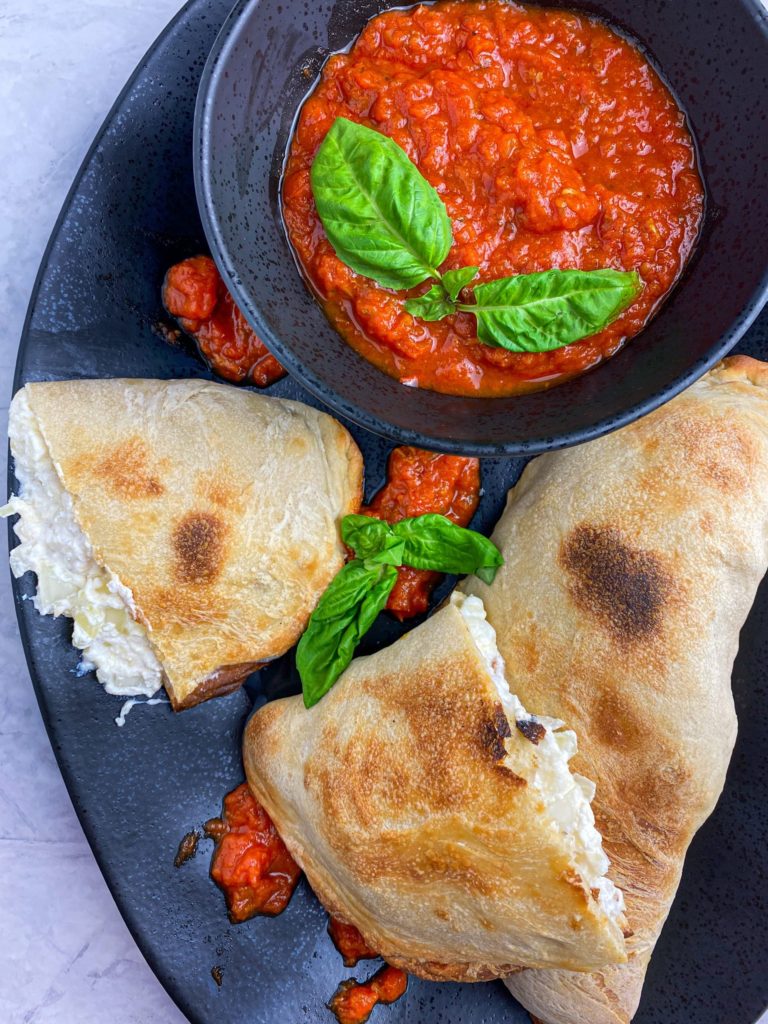
Cheese calzones are quick to make for a weeknight dinner, as a game-day snack, on a weekend date night, or as a fun activity with the kids! Last weekend, the hubby Eric was craving calzones, which we’d typically get from our local pizza joint. But we decided to try our hand at making calzones at home! It turns out they are SO easy and fun to make. My 3-cheese blend takes them to a whole other level, along with any other fillings of your choice!
Ingredients
- Pre-made pizza dough – buy good quality pre-made pizza dough in the grocery store or at your local pizzeria. If you prefer, you can make your own pizza dough from scratch!
- Ricotta cheese – ricotta cheese is essential in calzones. It’s the creamy goodness! I use whole milk ricotta cheese but you can also use part skim.
- Mozzarella cheese – mozzarella cheese adds gooey, stringy cheesiness!
- Parmigiano-reggiano cheese – parmigiano-reggiano (or parmesan) cheese adds depth of flavor.
- Extra virgin olive oil – olive oil is brushed on the top of your calzones to help them bake to golden perfection.
- Sauce for dipping – you can make or buy marinara, or a different type of dipping sauce! See dipping sauce ideas below!
- Fillings of choice – want to fill your calzones with something more than cheese? See the list below for calzone filling ideas!
Ingredient Substitutions
- Parmigiano-reggiano (parmesan) cheese – substitute grana padano or piave for parmesan cheese.
How to Make Calzones (The Brief Version)
- Shape the dough
Form a roughly 8-ounce dough ball. Stretch the dough ball into a thin, large circle.
- Mix together cheese (and other fillings)
In a bowl, mix together ricotta, mozzarella, parmigiano and a pinch of salt. Mix in any other fillings, or place on top of cheese mixture.
- Assemble
Add cheese/filling mixture to half of the dough round, leaving a small border as a crust. Fold over the other half, on top of the cheese mixture, to create a pocket. Tightly pinch closed your calzone pocket.
- Bake
Brush the top of the calzone with a bit of olive oil, and bake for 8-12 minutes until golden brown.
Difference Between Calzone and Stromboli
Calzones are basically folded pizzas whereas strombolis are rolled pinwheel pizzas. They’re both made with similar ingredients, except strombolis are rarely made with ricotta cheese like calzones. The major difference between the two is the shape and technique to assemble them before they’re baked!
How to Reheat A Calzone
Brush calzone lightly with olive oil. Place on baking sheet and heat until hot at 400 degrees, about 20-25 minutes. Of course, calzones are always best freshly baked!
Calzone Fillings (Mix-Ins)
If you want to fill your calzones with something more than cheese, here are some ideas!
- Diced Veggies: sweet onion, garlic, peppers, roasted peppers, mushrooms, broccoli, spinach, tomato, broccoli rabe, potatoes, corn
- Cooked Meats: crumbled sausage, salami, pepperoni, ham, bacon, chicken, ground beef
- Miscellaneous: olives, basil, other herbs, black beans
Sauces for Dipping
The classic way to serve an Italian cheese calzone is with marinara. You can buy jarred marinara or make your own grated onion marinara or a traditional marinara. For traditional marinara, simply stir together a 28-ounce can crushed tomatoes, 2 minced garlic cloves, handful fresh chopped basil, 1 tablespoon extra-virgin olive oil and salt. Heat on the stove until hot!
Substitute marinara for homemade vodka sauce, BBQ sauce, Buffalo sauce, or Ranch! Basically any sauce you can put on a pizza, you can dip your calzone in!
Summary
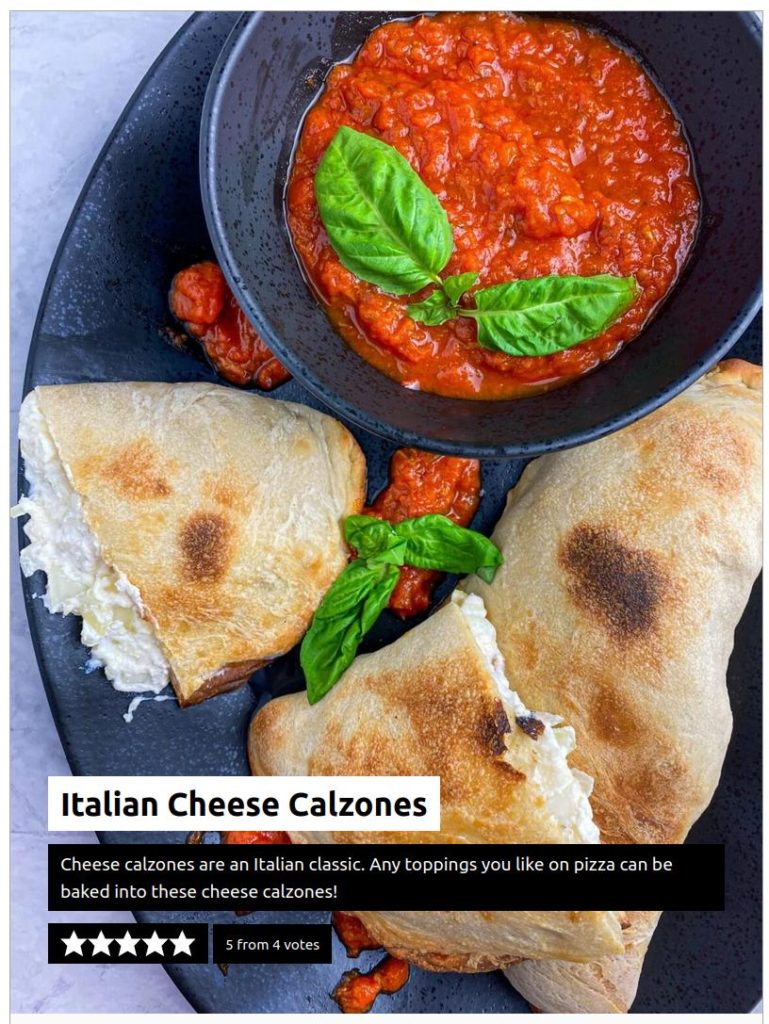
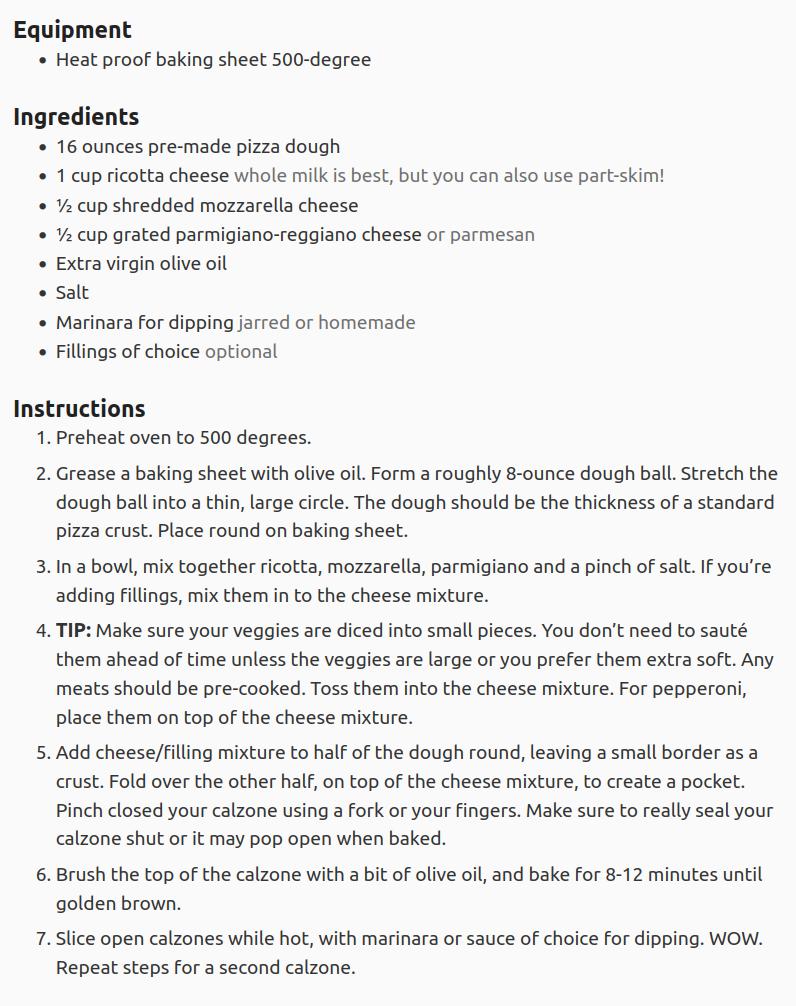
- Homemade marinara: 28-ounce can crushed tomatoes, 2 minced garlic cloves, handful fresh chopped basil, 1 tablespoon extra-virgin olive oil and salt, heated on the stove until hot.
A story about the Yakuza
Despite what we hear about Yakuza in Japanese media, their lifestyle appears to be different from what most of us think. (myself included.)
Here is a story I heard from my father-in-law.
My-father-in law, Den, has been running a small restaurant in a rural area of Japan for the past 30 years. It’s located in the remote part of the town.
Because of the restaurant’s location, many customers come to avoid the crowd in the city for a nice, quiet sit down meal (food is very good, by the way).
Naturally, and eventually, some Yakuza members discovered this quiet establishment, for they, too, needed a place to eat lunch and dinner to avoid crowds. So, they started to come to the restaurant frequently.
Now, my father-in-law is quite a big man for his generation: at the age of 80, he is 183 cm (6’1″) tall and weighs 100 kg (220 lbs). Thanks to his physical feature, he is not easily intimidated, even by the Yakuza.
When one of the Yakuza members noticed his missing pinky finger, their mood suddenly changed. A missing pinky is a sign of the Yakuza – whenever they commit a serious mistake (among their organization), it’s their custom to cut their finger off.
“Hey grandpa, what did you do,” one of the Yakuzas asked.
“What do you mean,” Den asked.
“Your index finger.”
“Oh this? My finger got caught in the electric winch on my boat.”
“Your boat,” The Yakuza asked.
“Yes, I am a fisherman also. I go and catch fish and sell, when the restaurant is not so busy,” Den said.
“You are not ex-Yakuza,” The Yakuza asked.
“No. Are you?”
“Yes, we are. We thought you were because your index finger is missing. We thought you slept with your boss’s wife or girlfriend. That’s when we must cut our index finger. We normally cut our pinky for the mistakes. We thought you were reckless and courageous, worth admiring.”
“Really? Why courageous,” Den asked the Yakuza.
“Because you are reckless, we thought.”
“Why is it good to be reckless?”
“Because we cannot be. Police know what we are doing and where we are. They always have their eyes on us. Ordinary people put a petition together and force us to move out of the town. We cannot go to ordinary stores and Onsens (Japanese public hot springs prohibit a person with a tattoo to enter the bath because many of Yakuza members have tattoos.)” the Yakuza explained.
“How about all the other crimes and drug dealing we hear on the news,” Den said.
“Those are committed by the younger guys. They have too much energy and ambition, and they will do almost anything to prove their worthiness. They become Yakuza because they don’t want to deal with the rules set by the “ordinary” world, and the fact is, there are some rules in the Yakuza world, our own rules. We’ve been living in this world, and we learned and adapted to those rules, so we know better than to commit a small, stupid crime you hear about and see on TV. We almost never kill ordinary people or other Yakuza family members because, as I said, police are watching every move we make. Once we kill someone, they will know, so, it’s hard to kill someone without getting caught. In fact, the police can arrest any of us any time and shut us down by arresting the majority of our members. We think that’s harassment. We need as many members as we can to survive as a Yakuza organization. We never deal drugs because, for one, it’s really difficult to import into Japan. Even if we could, it’s hard on the buyers/users because drugs destroy their lives and, quite often, their families too. In fact, it’s hard on us. Think about it. Your product kills your customer. How would you feel to serve your food, knowing it’s going to kill us for sure? That’s hard as a person to watch.”
“Really? It sounds like you guys live in a very restricted world,” Den said.
“Yes, it’s very restricted. The challenge is that at the same time, we have to behave in the way to meet people’s expectations,” the Yakuza replied.
“What expectations,” Den asked the Yakuza.
“Well, most people who do not know Yakuza think we are loud, reckless and dangerous, like running around loose and engaging in all kinds of illegal activities. In fact, that’s not what we do. We do jobs ordinary people don’t want to do. Things that are in the “gray area” can turn either legal or illegal, and someone has to do them. Ordinary people come to ask us to perform those jobs because, for whatever reason, they are unable to do the jobs themselves, like extortion. That’s where we come in. Also, because of people’s expectations, in the view of the general public, we have to pretend and act like the stereotypical image of what Yakuza should be: loud, fearsome and reckless. We have to throw loud parties in our office so that people will notice us and be fearful of us. But, most of the time, we live quietly because otherwise, there will be no more places for us to live. Truth be told, many of us actually do live in fear, as we feel being separated from society.”
“Sounds like it’s a tough life,” Den said quietly.
“Yes, it’s tough, and probably tougher than yours. So, that is why I’d never recommend anyone to become a Yakuza,” the Yakuza said to Den.
When My Cat Feels Sad
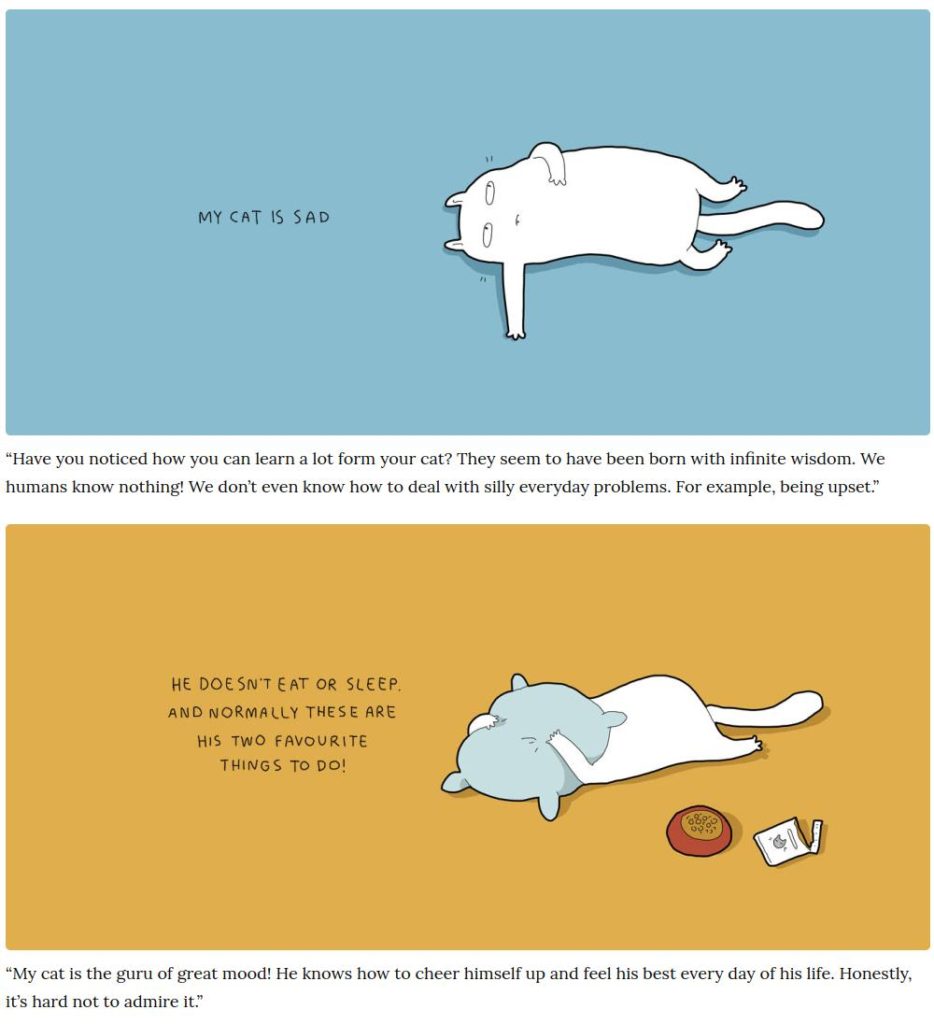
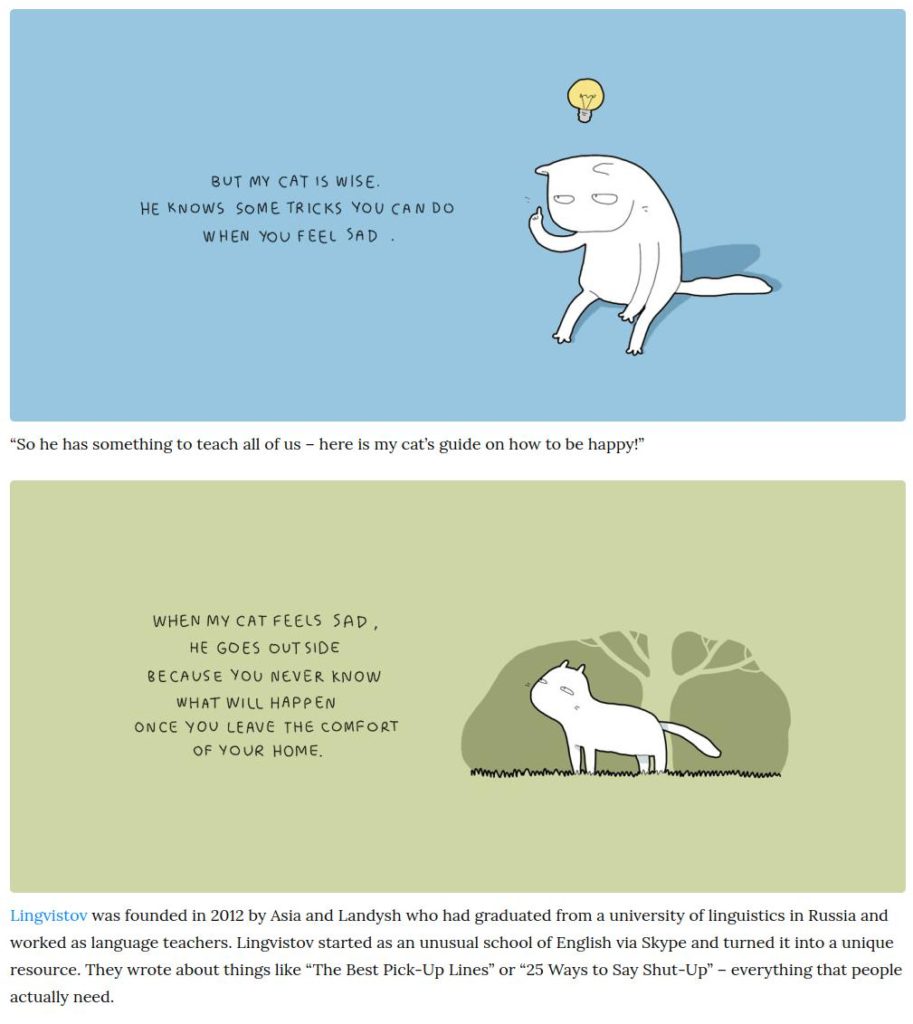
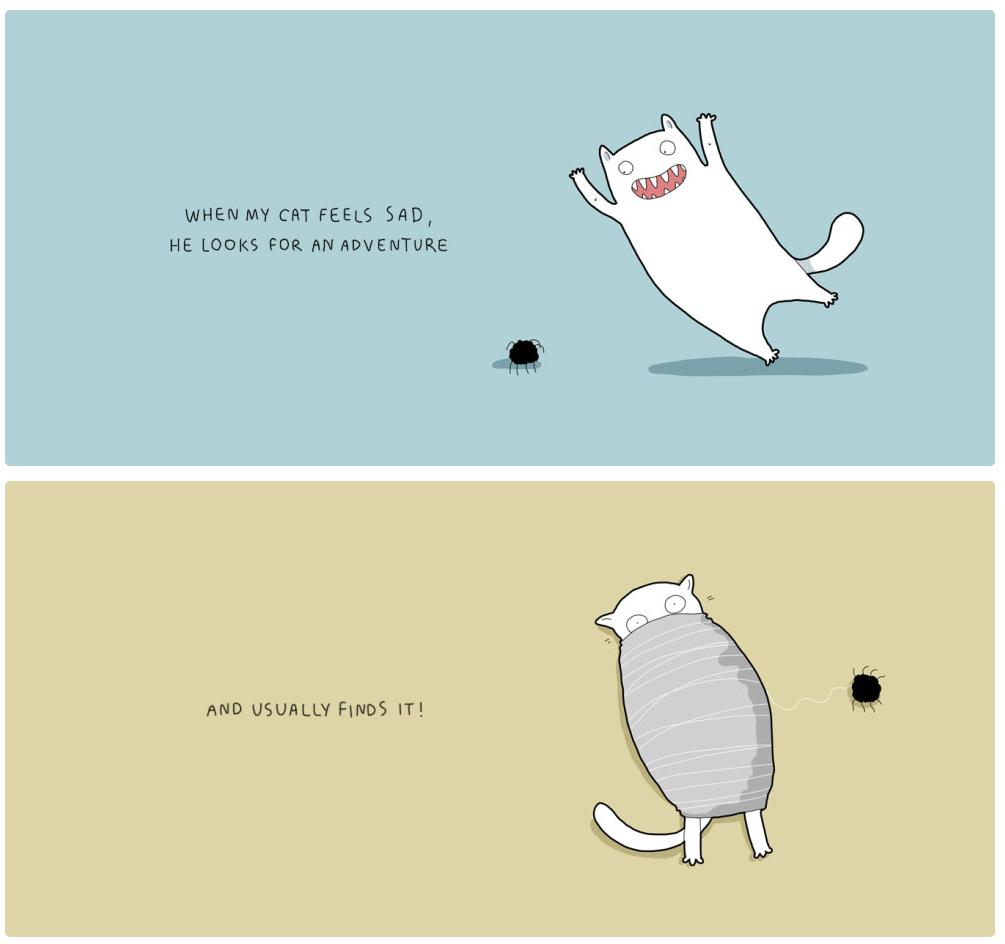




Love Child
My father joined the Navy in 1942 at the age of 17 and went to war on diesel submarines in the South Pacific. After WW2, he was assigned to duty in Japan as part of the occupational forces. There he met a local Japanese girl he wanted to marry, but it was prohibited to do so until the early ’50s when President Truman allowed it. Dad went back to Japan and married the girl he met during the occupation of Japan.
Dad was also involved in the atomic bomb tests in the South Pacific islands of Bikini Atoll in “Operation Crossroads.” Dad passed away in 1998, from lung cancer, and I submitted a claim to VA for a service-connected death and it was approved in record time. My mother lived until 2015. After mom passed away, my sister and I took our time to clean out our parents’ home. I stumbled on photos of my father with a young female child. There was nothing else associated with the picture. In my mother’s possessions were letters written in Japanese that we thought were from family members. During one trip to the house, there was a letter from Japan in the mail box. My sister decided to get the letter interpreted. To our surprise, the letter was from a Japanese woman who claims to be the daughter of my mother and father that he had during the occupation of Japan. The Japanese woman wanted to know why her mother hasn’t written her or responded to her phone calls. It was after this revelation that we decided to get all the letters mother had saved and get them interpreted. One of the letters had an email address so I used an app called Google Translate and wrote a letter to the Japanese woman. I learned that my mother and father had a child during the occupation of Japan in the late 1940s. This woman whose name was Terri had pictures to prove that she was a daughter of my parents. To my horror, Terri said our parents abandoned her because she lived with our mother until age 7 when dad returned to Japan and married our mother and brought her back to the USA. I learned that Terri was put up for adoption and the names of the birth parents were falsified thereby making it impossible for my parents to bring Terri back to the USA. Since my father was a career Navy Master Chief Petty Officer, he did not want the love child to hurt his career since fraternization during the occupation of Japan would result in a court martial. So, my parents made the decision not to adopt their real daughter and bring her back to the USA.
In my many Google Translate emails to Terri, I learned that our mother was one of six (6) children. Of the 6, two were female, mom and Terri (if Terri is her daughter, she can’t be her sister as well) and four (4) were boys who I was told were soldiers in the Japanese Imperial Army and fought Americans in the South Pacific and all were killed. I learned that my mother was disowned by her family for marrying an America military man when her brothers died fighting Americans. I continue to write Terri and we are trying to organize a reunion but haven’t decided on when or where.
I would have never imagined that my parents had a love child while dad was involved in the occupation of Japan but short of a DNA test, I am convinced that Terri is my blood sister. To this day, my sister and I are amazed that our parents never told us that they had a daughter and abandoned her in Japan after WW2. I think that this story would make for a good book. This is something I have been wrestling with so I can get the money to have a reunion with my long-lost sister in Japan. This is a true story.

A life hack
As a kid, I remember watching a cartoon in which the hero is arrested and imprisoned in a tower.
There’s an elderly man there who has spent his entire life in prison.
The gate opens as the hero requests to be let out. The hero exits the room. “You mean all I had to do was ask?” the old man mutters as he looks at the open door and then turns to the audience.
I used to giggle at this as a youngster, but as I think on my life, there have been many times when I’ve felt like that old man.
I had a three-year crush on someone I never spoke to, I never asked questions in meetings, and I never pushed for promotions.
I’ve tried with doing what the hero in the tower did and asking for what I want over the last five years.
And, in many cases, the door did really open, precisely as it did in the cartoon.
This can range from minor requests such as not having olives in my salad to more significant demands such as getting 20% of my work time to pursue self-directed activities.
You’ll be surprised how far simply asking for things will get you whether you’re honest and generally skilled.
A policeman recounts a “it doesn’t seem right” moment…
Back in the 90s as a young Police constable working in the Home Counties I decided to do a welfare check on a woman who had been the victim of domestic stalking and harassment. I had arrested her estranged husband and after interview he had been charged with harassment and bailed to magistrates court with conditions not to contact his wife.
Anyway, it was a quiet afternoon and I was in the area so I thought it would be a good idea to pop round and update her on the case and make sure she was ok.
On approaching the front door I could hear the sound of crying children inside. I knocked on the door repeatedly but there was no reply. I announced that it was the police and that I would force entry if I wasn’t allowed in as I was concerned for the welfare of the children. The woman opened the door and asked me what I wanted, which I found strange so I asked her if she was OK? She replied that she was and I should go away. I said that I wanted to see the kids to make sure they are ok. The woman called the kids to the door at which point I pulled them outside. I then grabbed the woman by the wrist and dragged her through the door as well. At that point the estranged husband appeared, from behind the front door. He was holding his right hand behind his back. I punched him in the solar plexus as hard as I could and he dropped to the floor groaning, as he did so he dropped an 8 inch kitchen knife.
I quickly handcuffed him to the rear and called for backup to transport him to the nick. I dragged the husband to the living room and sat him on the sofa and waited for my colleagues. As we waited I saw him glancing at a large black hold-all bag sat on the floor in the middle of the room. I opened the bag and inside was an axe, another knife, a large amount of plastic sheeting, a set of disposable coveralls and latex gloves.
The husband had basically turned up five minutes before I had with a ‘murder kit’. I honestly think that if I hadn’t knocked on the door when I did then he would have murdered his wife and children.
I’m glad that I followed my instincts and I’m glad that I am 6 foot 4 and 18 stone and he was 5 foot 7 and 12 stone otherwise the result could have been very different.
I love this man.
There is this guy, who is sitting on a subway with different, fake book covers. I find this so funny, so here are a few more. Enjoy! 🙂







Swiss Steak
Swiss Steak is not Swiss. “Although many might think Swiss steak comes from Switzerland, in reality, the name comes from the ‘swissing’ technique for tenderizing meat,” according to The Spruce Eats. “Tough cuts of meat go through a mechanical tenderizer, or a swissing machine, and come out the other end with cube-shaped indentations.”

This recipe for Smothered Swiss Steak is pure comfort food at its finest. It’s at the top of my list for when there is a chill in the air, and I’m looking for something warm and cozy for supper.
And although you can prepare this Swiss Steak recipe by simmering it on the stovetop, I like to braise it in the oven for a few hours. Because when it’s cold and blustery outside, it just makes my kitchen extra warm and inviting to have a pot full of something delicious slow-cooking in the oven. Also, can I just say that while these Swiss Steaks are in the oven simmering away, the whole house will be just amazingly fragrant with the aroma of home-cooked goodness!

But I do tend to think of this recipe as something a bit old-fashioned (in a really good kind of way). This dish is something from my childhood, that my mom or grandma would prepare for supper on a cold fall or winter evening. Back in those days, growing up in Pennsylvania, fall was just magical to me (and still is to this day!) Hearty, warming foods were standard fare on those crisp autumn, after-school evenings, and were definitely a part of the magic.
Ingredients
- 1/4 cup all-purpose flour
- 1/2 teaspoon salt
- 1/4 teaspoon ground black pepper
- 1 teaspoon granulated garlic
- 2 pounds cubed steak (cut into serving-size pieces if necessary)
- 1/4 cup vegetable oil (or other high-temperature cooking oil)
- 1 onion, diced
- 1 stalk celery, diced
- 1 green bell pepper, thinly sliced
- 8 ounces of cremini or white button mushrooms, sliced
- 2 cloves garlic, minced
- 3 tablespoons tomato paste
- 1 (15-ounce) can diced or stewed tomatoes (or use 1 pint of home-canned tomatoes)
- 2 cups beef broth
- 1 tablespoon Worcestershire sauce
- 1/2 teaspoon dried thyme
- 1 teaspoon sugar
- 1 pinch celery seed (optional)
- 2 tablespoons of water + 2 tablespoons cornstarch
Instructions
- Preheat oven to 325° F. In a large resealable plastic bag, combine flour, salt, pepper, and granulated garlic. Add steak, a few pieces at a time, and shake to coat.
- On the stovetop, heat oil in a cast-iron Dutch oven (or other heavy, oven-safe pot) over medium-high heat. Brown steak in oil on both sides. Remove steaks to a plate.
- To the same pot, add the onion, celery, bell pepper, and mushrooms. Turn the heat down to medium, and cook and stir for 6-7 minutes, or until vegetables are beginning to soften. If needed, add a little extra oil. Add garlic and tomato paste, and cook for 1 additional minute.
- Stir in diced tomatoes, beef broth, Worcestershire sauce, thyme, sugar, and celery seed. Scrape the bottom of the pot with a spatula to release all of the flavorful bits. Return steaks to the pot, making sure they are covered by the gravy.
- Cover and bake 1 1/2 to 2 hours, or until meat is tender. At this point, remove the pot from the oven and place it on the stovetop. Remove the steaks to a plate, leaving the gravy in the pot.
- In a small bowl, combine corn starch and water into a paste; stir into gravy. Bring to a boil over medium heat, stirring continuously, until gravy has thickened. Serve steaks with gravy, and mashed potatoes, egg noodles, or cooked white rice.
What are the ingredients for Smothered Swiss Steak?
Aside from being a nostalgic kind of recipe, though, I think it’s also a bit of an old-fashioned because I use cubed steaks for this dish, a cut of beef that I really don’t see too often in modern recipes. I really believe these steaks deserve a revival, though, because when properly cooked low and slow, cubed steaks are just oh-so-tender. And as an added bonus, they are also typically very inexpensive. Often I can find cubed steaks on sale for less than the price of regular ground beef. But if you can’t easily find cubed steaks, just go ahead substitute thin-cut top round steaks.
And the gravy for these steaks? It’s a beefy-tomato gravy, filled with tender bell peppers, onions, celery, and mushrooms. And here comes the “smothered” part – this rich, thick, savory gravy is just begging to be smothered, not just over the steak, but also over a scoop of mashed potatoes, egg noodles, or even rice. Truly down-home comfort food!
Meet Shirō Ishii – a serious piece of shit
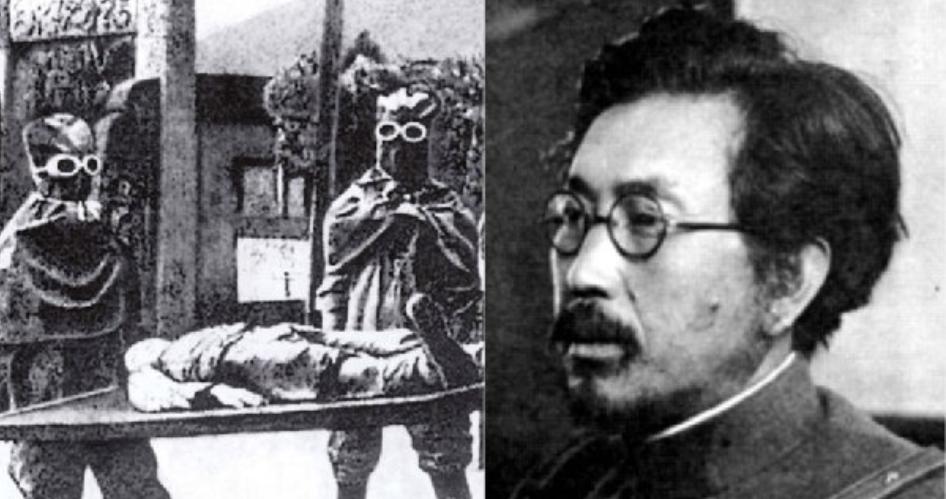
This guy was a Doctor and microbiologist- and a rather smart one at that. He was regarded as a brilliant person for nearly his entire life. He was well educated and joined the army as a doctor. While there he caught the eyes of his superiors and was sent for further education at Kyoto Imperial University.
During WW2 he was placed in charge of Unit 731 and this is what he was known for.
What was unit 731? Well, they were a scientific unit that conducted experiments and thought up new ways to win the war. Some examples of things they did include
- Imprisoning women, raping them until they got pregnant, and then running horrid painful experiments on them just so they could see how certain poisons affected pregnant women.
- They would infect people with syphilis and then cut them open (while alive and awake) so they could see what their bodies did as the infection progressed. Women, men, and even children were forcibly infected
- This is called vivisection- its the practice of cutting someone open while alive to see what their body is doing and its typically done when experimenting on animals. In unit 731 they did it to people without anesthesia- always resulting in a slow agonizing death for the person.
- Injected people with animal blood to see what happens (bad way to die)
- Placed people in centrifuges and spun it until they died
- Deprived prisoners of food and water to see how long it was until they died
- Placed people in low-pressure chambers until their eyes popped out
- Burned people alive to see how long they would live
- Injected people with saltwater to see what would happen
- Poisoned people to see the effects
- gave people radiation poisoning to see the effects
- Leave 3-day old babies in the cold just to see how long it took them to freeze to death
- Tested flamethrowers on live people
- Tested grenades on live people
- Removed organs for fun. For instance, they would remove someone’s stomach and attach their esophagus to their intestines directly.
- Tested hundreds of diseases and biological weapons on people
In all, around 10,000 prisoners were killed by Unit 731 and as many as 20,000 were tested on. The biological weapons produced by this unit were used to kill as many as 500,000 civilians
On a side note not even the Nazis used chemical weapons in WW2 (they only did in concentration camps). The ONLY nation to employ chemical weapons against civilian and military targets in WW2 was Japan.
You may wonder what happened to Shirō. I mean we caught him and put him on trial for war crimes right?
Nope
He was given full immunity in exchange for full disclosure of his tests. American microbiologists stated that Shirō’s findings were extremely valuable and impossible to replicate unless the experiments were done again. He was protected by the United States, provided with an ample salary, and sent off to the United States to live a life in luxury.
Shirō lived out the remainder of his life a free man in the United States, and traveled frequency to Japan where he was treated like royalty. He died in 1959.
Si Kaddour Benghabrit

He was in charge of a mosque in Paris during World War II. He was originally born in Algeria before immigrating to France.
When World War II broke out, Germany began deporting Jews from France to concentration camps.
Si Kaddour began offering shelter to lots of Jews through willing Muslim families in the area.
When German inspectors came, he would lie about the records of Jews, saying that they were Muslim. He eventually had cellars and basements in mosques where he would allow the Jews to hide during the war. He also gave them fake certificates that would certify that they were Muslim, enabling them to escape certain death.
He had an open-door policy as well at his mosque. If any of the attendees had Jewish friends in need of refuge, they could bring them with them.
Si Kaddour saved 500 Jews by the end of the war. He risked his life in the process. And most people don’t even know of him.
A love bomber…
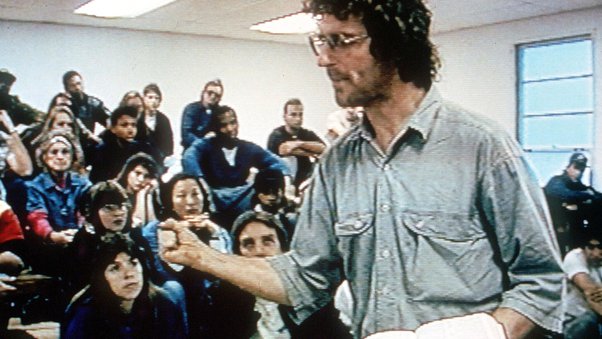
-
-
- Day 1: “Dang you’re gorgeous.”
- Day 2: “I feel like we have so much in common.”
- Day 3: “I really like you.”
- Day 4: “I feel like we’re soul mates.”
- Day 5: “I love you.”
-
Love bombing is an attempt to influence a person by giving them affection and attention. Cult leaders like David Koresh used this tactic to control their followers.
Having experienced this before, the only way I can describe it is as if a sun is shining on you constantly for days, weeks and months. You’re blinded not by love, but by the idea of being wanted.
The love bomber makes you feel like you’re in a trance. They shower you with compliments, buy you gifts, promise a future and bombard you with romantic texts. It seems too good to be true because it’s an illusion.
Love bombers feed you this attention to gain something in return. Whether that’s money, power, control or sex.
They can’t love you because they don’t know you to love you.
They can’t love you because they don’t understand the meaning of the word.
Relationships take time. Boundaries, opinions and space need to be valued. Relationships that start off by resembling a romantic movie is an instant red flag.
It’s easy to create an attachment with a love bomber.
It’s harder to escape.
Get out before it becomes emotionally abusive.
Easy Buttermilk Drop Biscuits
Drop biscuits are one of the easiest baked goods to make.
Despite being so easy to make, these biscuits are tender, flaky, buttery, and one of the single best things you’ll ever put in your mouth.
And, by the way, they go GREAT with real salted butter.

I’ve been nicknamed the “Biscuit Queen” by my family, because whenever we go out to eat for breakfast, the first thing I look for is biscuits. If there’s a biscuit on the menu, it’s going to be eaten.
Creating this recipe was the best AND worst decision. Since I’m a biscuit’s #1 fan, I feel like I’m well-qualified to tell you how good these little things are. Since I want to make them every week, my biscuit obsession can get a bit unhealthy…HA!
Serve with My Mom’s Homemade Strawberry Preserves.
What Are Drop Biscuits?
Drop biscuits are easy to make because they are made by simply dropping dough onto a baking sheet as opposed to rolling out and cutting dough into biscuits. No need for extra time or dishes!
Ingredients for Drop Biscuits
You need only 6 ingredients to make the most incredible drop biscuits:
- All-purpose flour – flour is the base for our biscuits!
- Cold buttermilk – buttermilk is the key ingredient for fluffy, flaky, tender drop biscuits. It also helps your biscuits rise.
- Cold butter – butter gives biscuits flavor and moisture.
- Baking powder – a combination of baking powder and baking soda helps drop biscuits rise and have a flaky, tender texture.
- Baking soda – see above!
- Salt – salt adds flavor.
Why COLD Butter and Buttermilk for Biscuits?
Cold ingredients, especially butter, are essential in biscuits. The cold butter pieces in the dough will produce steam when placed in the oven, creating moisture pockets and yielding a tender, flaky biscuit.
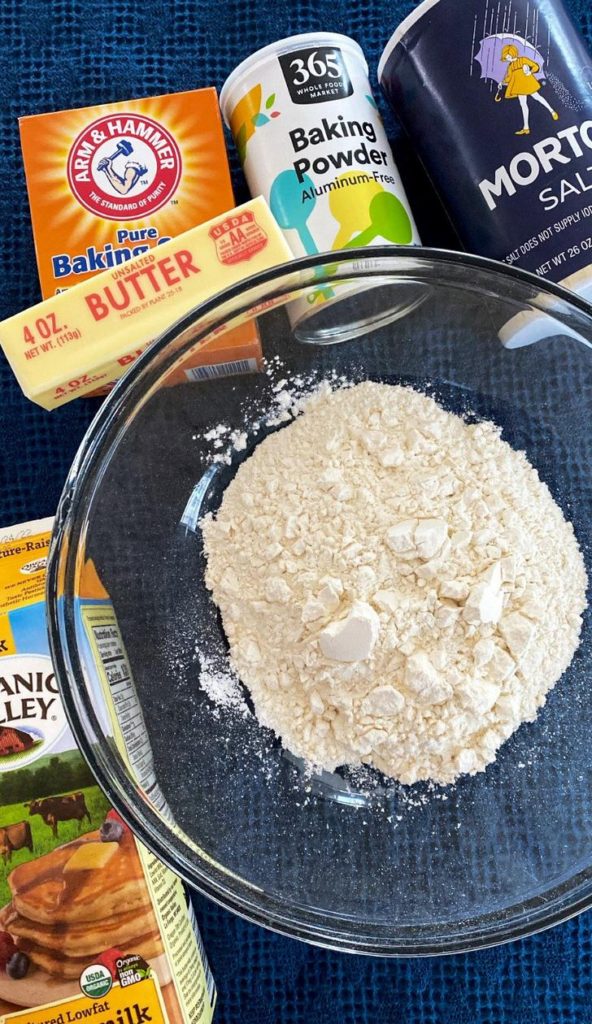
How to Make Easy Drop Biscuits
Making drop biscuits is SO easy. You can make the dough and bake them in just 30 minutes! FULL instructions are in the recipe card below (this is just an outline!).
- Combine dry ingredients.
In a large bowl, use a whisk to combine flour, baking soda, baking powder and salt.
- Add cold butter.
Add in cold butter chunks. Use a fork or pastry/biscuit cutter to cut the butter into the dry ingredients to form a fine crumble.
- Add buttermilk.
Add buttermilk and mix until just combined. The dough should be just wet enough to form a loose ball. Add a splash more buttermilk if the dough is too dry to form a loose ball.
- Form drop biscuits.
On a greased baking sheet, use a ¼ cup measure to drop dough balls about an inch apart.
- Bake.
Bake for 11-16 minutes at 425 degrees, until just golden.
What to Serve With Drop Biscuits
These buttermilk drop biscuits are absolutely AMAZING alone. But here are a few ways you can serve your biscuits to make them extra special:
- With 20-Minute Pumpkin Butter
- With My Mom’s Homemade Strawberry Preserves
- With Homemade Honey Peanut Butter
- As a dessert with Hot Fudge Sauce
- As a Pulled Pork Biscuit Slider

How to Store Biscuits
Drop biscuits are best stored in an airtight container. They will keep well for 3-4 days!
Refresh them by heating them in a foil package in the oven at 350 degrees for 5-10 minutes.
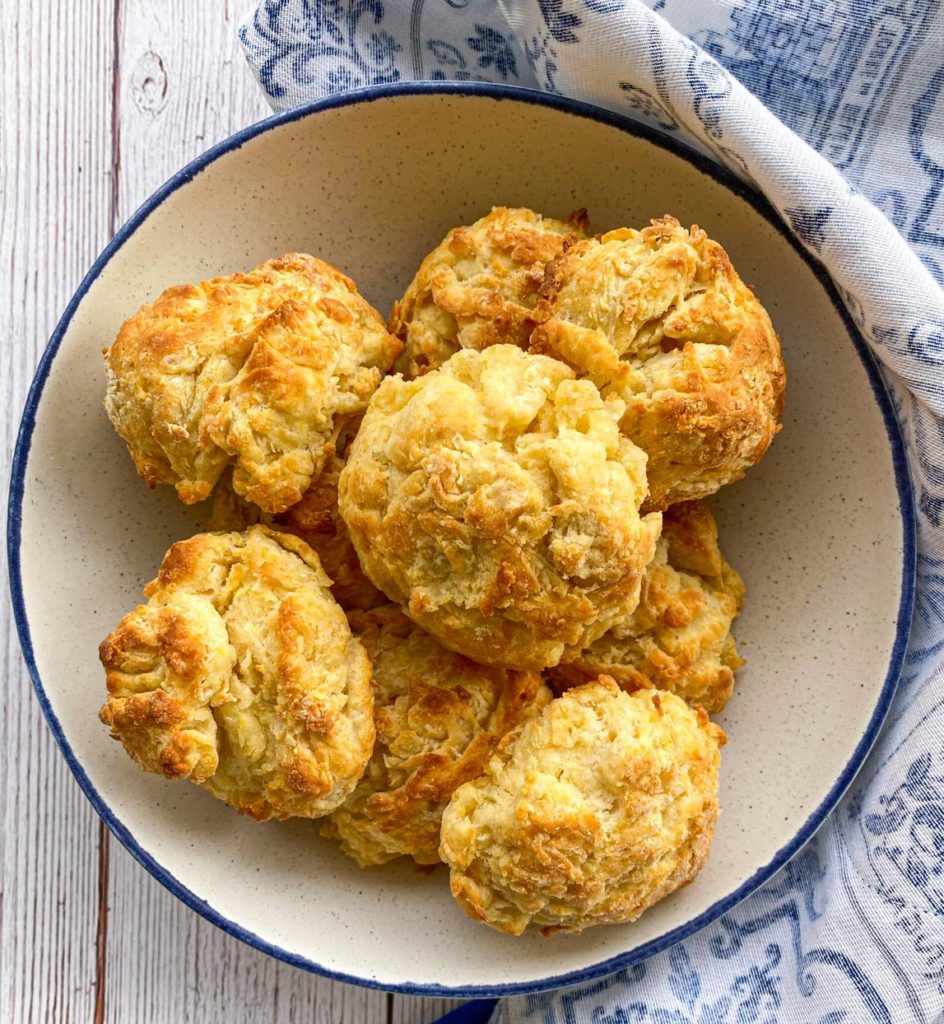
…

Keanu Reeves
He was abandoned by his father at 3 years old and grew up with 3 different stepfathers. He is dyslexic. His dream of becoming a hockey player was shattered by a serious accident. His daughter died at birth. His wife died in a car accident. His best friend, River Phoenix, died of an overdose. His sister has leukemia.
And with everything that has happened, Keanu Reeves never misses an opportunity to help people in need. When he was filming the movie “The Lake House,” he overheard the conversation of two costume assistants; One cried because he would lose his house if he did not pay $20,000 and on the same day Keanu deposited the necessary amount in the woman’s bank account; He also donated stratospheric sums to hospitals.
In 2010, on his birthday, Keanu walked into a bakery and bought a brioche with a single candle, ate it in front of the bakery, and offered coffee to people who stopped to talk to him.
After winning astronomical sums for the Matrix trilogy, the actor donated more than $50 million to the staff who handled the costumes and special effects – the true heroes of the trilogy, as he called them.
He also gave a Harley-Davidson to each of the stunt doubles. A total expense of several million dollars. And for many successful films, he has even given up 90% of his salary to allow the production to hire other stars.
In 1997 some paparazzi found him walking one morning in the company of a homeless man in Los Angeles, listening to him and sharing his life for a few hours.
Most stars when they make a charitable gesture they declare it to all the media. He has never claimed to be doing charity, he simply does it as a matter of moral principles and not to look better in the eyes of others.
This man could buy everything, and instead every day he gets up and chooses one thing that cannot be bought: To be a good person ♥ ️
Do you want more?
You can find more articles related to this in my latest index; A New Beginning. And in it are elements of the old, some elements regarding the transition, and some elements that look towards the future.
New Beginnings 4.
Articles & Links
Master Index.
- You can start reading the articles by going HERE.
- You can visit the Index Page HERE to explore by article subject.
- You can also ask the author some questions. You can go HERE to find out how to go about this.
- You can find out more about the author HERE.
- If you have concerns or complaints, you can go HERE.
- If you want to make a donation, you can go HERE.
.

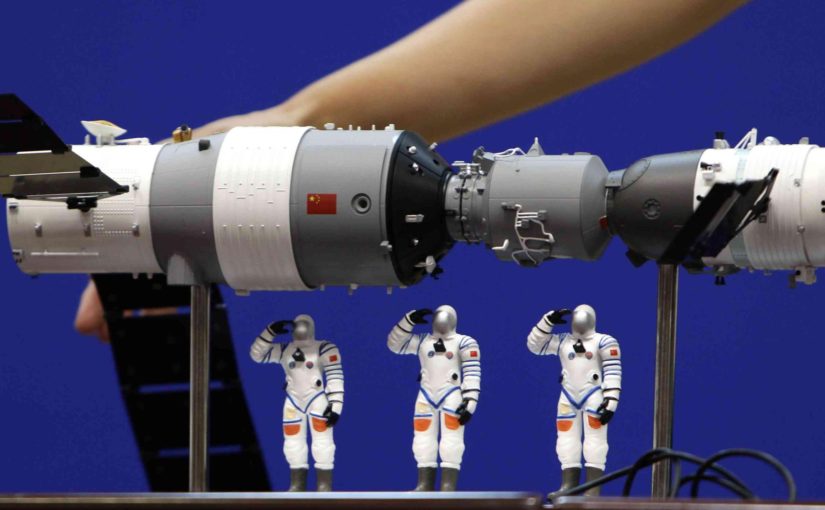

So the Pfizer mRNA jab resulted in a 97% fetal fatality rate in pregnant women, eh? That gets me to thinking.
The recently bombed and demolished Georgia Guidestones and numerous “watermelons” (green on the outside, red on the inside) have called for reducing Earth’s human population to no more than 500 million. The population is now not much shy of 8 billion. Do the math: that would be a 94% drop.
I don’t think this outcome from the Pfizer shot is a coincidence. When it comes to the globalist and Marxist crowd, there are no coincidences. The Davos/World Economic Forum (Klaus Schwab’s pet project) just called for getting rid of “wasteful” private cars on top of so many other similar sentiments, so that should give everyone an idea of what they have in mind for all of us.
“You will own nothing and be happy” (to be alive) after seeing 7.5 billion others exterminated, if they have their way. The mRNA jabs provide a clue for how that might happen. And now they’re trying to ramp up fear of monkeypox…